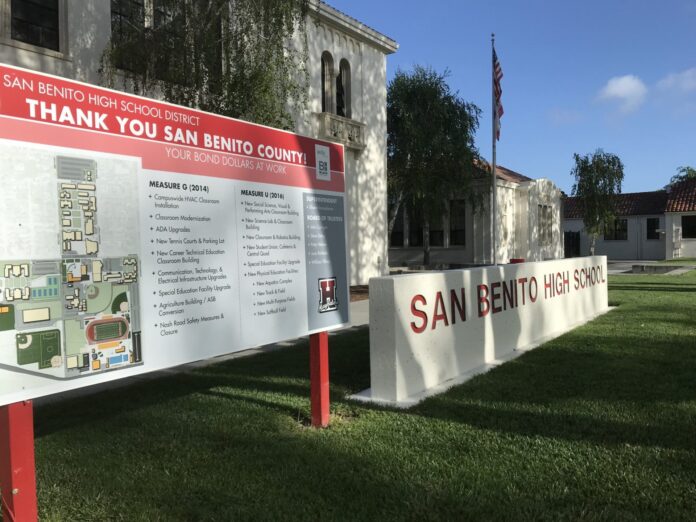Courtesy of San Benito High School:
Most ninth- and 10th-grade classes at San Benito High School in 2018-19 will follow the grading practices guidelines that were piloted in select freshman classes last year, according to Educational Services Director Elaine Klauer. Some 11th- and 12-grade classes will participate in the 0 to 4 scale, rather than the traditional F to A grading practice, but the focus will be on the freshman and sophomore classes in Year 2 of the program.
The purpose of grading within the new Grading Practices policy, Klauer said, “is to provide students and parents with a snapshot of our students’ academic and citizenship/work habit performance.”
Academic grades are based on student proficiency and not by nonacademic factors, such as citizenship and work habits — which will be evaluated separately.
“Students will receive three separate marks,” Klauer noted. “One for their academic grade, a second mark for their citizenship performance and lastly a third mark for work habit performance.”
Ninth- and 10th-grade teachers who recently attended a two-day workshop on grading practices on campus this month will not penalize students for late work, but rather provide them with opportunities to get the work done for credit.
“Research does not show that penalties (such as zeroes in the gradebook) encourage students,” Klauer said. “We do not believe in artificially inflating grades through the use of extra credit. We commit that grades are reflective of student proficiency toward learning standards.”
Four Ideas
The new grading practices at San Benito High School encompass four main ideas:
- Students will be provided feedback regarding progress and learning
- Students will have multiple opportunities to demonstrate learning.
- Academic and Citizenship/Work Habits grades will be graded separately.
- Students will receive an academic grade on a rubric scale of 0-4 and a Citizenship/Work Habit grade (O, S, NI, U).
Providing Feedback
San Benito High School believes that providing accurate and timely feedback to students and parents regarding performance on identified standards and targets is imperative to student learning and progress toward proficiency. “Students will be assessed on content standards and some standards may encompass several targets, while others may encompass very few,” Klauer said. “Learning targets are derived from the standards and become the basis for assessment, instruction, and ultimately the feedback that is communicated to students and families for reporting purposes.”
Citizenship and Work Habits
The school believes that citizenship and work habits are critically important in the overall development of students. Therefore, SBHS believes there is significant merit to reporting about citizenship (behavior in school and online) and work habits (participation, work completion, collaboration, and engagement). “We also ensure that citizenship and work habit grades will not influence an academic grade and will be reported separately in our reporting structure,” Klauer said.
Multiple Opportunities to Demonstrate Learning
San Benito High School believes that all students learn at high levels by being offered multiple opportunities to demonstrate they are proficient on identified content targets. In order to qualify for a reassessment (re-taking part or all of a test, quiz or other assignment) the student must demonstrate new evidence of learning since taking the initial assessment — meaning they can’t just skip an assignment to “buy more time.” The requirement for new evidence of learning is determined by the teacher and may be embedded in the Academic Focus Time offered to all students three times a week. Reassessment can occur in multiple forms, such as another assessment similar to the first, oral discussion with the teacher, or another method that is mutually agreeable between the teacher and student.
“There is a cutoff point at the end of of the fifth week of each grading period for taking a reassessment,” Klauer said, noting that this policy will be made clear to students by teachers early in the school year. “This allows teachers time to process the grade in a timely manner. Students do not have to retake an entire assessment. If a student struggles on a particular target of an assessment, that student is allowed to reassess on solely that target to replace the last score entered with the most recent proficiency score,” she said.
Final exams are exempt from reassessment and are considered a final summative assessment.
Grading with a Rubric Score of 0-4
San Benito High School believes grading should provide snapshots to students and parents about how students are performing against academic and behavior targets. The standards/learning targets are measured on a rubric scale from 0-4 as indicated below.
All assignments will be graded on a scale ranging from four (4) to zero (0). The grading categories, grade weighting and exact percentages required to earn each grade will be determined by teacher teams (PLC’s: Professional Learning Communities) and shared with students:
4
Student demonstrates mastery of the standard(s)/learning target(s).
3
Student is approaching mastery of the standard(s)/learning target(s) with few mistakes.
2
Student is making progress towards mastery of the standard(s)/learning target(s).
1
Student demonstrates some grade level mastery but is in serious danger of failing.
0
Student does not show any evidence of mastery.




